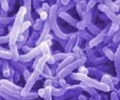
Ms. Melanie Blokesch at EPFL found that V cholerae uses a predatory killing device, a spring loaded spear, which constantly shoots out in all ways, to compete with surrounding bacteria and steal their DNA. This weapon is called the "type VI secretion system" (T6SS) and is known to exist in many types of bacteria.
V cholerae attacks any bacterium that is in its proximity with the spear and the spear punches a hole into them. This leads to the death of the other bacteria and release of their genetic material, which the predator pulls into itself. This spear-killing, predatory behavior is triggered by the bacterium's environment. The cholera bacterium naturally lives in water, such as the sea, where it attaches onto small planktonic crustaceans. There, it feeds on the main component of their shells, which is a sugar polymer called chitin.
V cholerae goes into an aggressive survival mode called "natural competence," when chitin is available. Ms. Blokesch's lab tested different strains of the bacterium from all over the world. The researchers grew these bacteria on chitin surfaces that simulated their natural habitat on crustaceans.
They found that the tiny spear is not only part of V cholerae's natural survival system, but it also contributed to the transfer of genes that could make the bacterium more resistant to threats, even to antibiotics. On this, Ms. Blokesch commented that, "Using this mode of DNA acquisition, a single V cholerae cell can absorb fragments containing more than 40 genes from another bacterium."
The researchers said that the importance of this study lies in the fact that horizontal gene transfer is a widespread phenomenon in bacteria, and it contributes to the dispersal of virulence factors and antibiotic resistances. In addition, this molecular spear might also kill protective bacteria in the human gut when the chitin-mediated activation of the spear-killing device in the bacterium is ingested by patients, hence making it more dangerous. The study is published in the journal Science.
Advertisement










